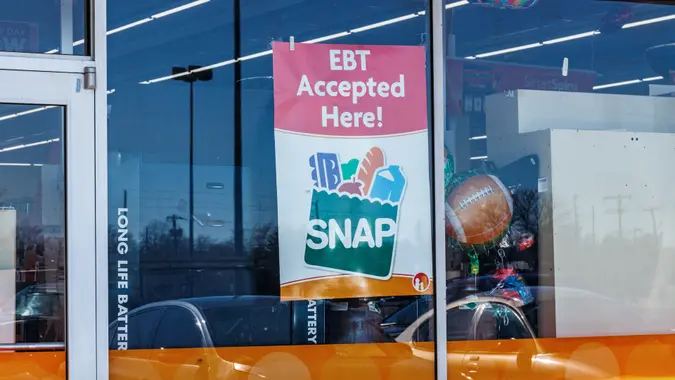What Income Is Considered Poverty Level in Florida in 2024?

Commitment to Our Readers
GOBankingRates' editorial team is committed to bringing you unbiased reviews and information. We use data-driven methodologies to evaluate financial products and services - our reviews and ratings are not influenced by advertisers. You can read more about our editorial guidelines and our products and services review methodology.

20 Years
Helping You Live Richer

Reviewed
by Experts

Trusted by
Millions of Readers
Florida may attract vacationers and tourists with its stunning beaches and tropical environment, but not everyone who lives there has the means to live lavishly. Of Florida’s 21.5 million population, about 12.7% live in poverty, according to the U.S. Census Bureau. That’s more than 2.7 million Floridians.
A higher percentage of Sunshine State residents languish in poverty than in the country as a whole. Nationally, the rate is 11.5%, according to 2022 Census data, the latest on record.
Even so, Florida is moving in the right direction.
In 2013, 16.3% of the state’s residents lived below the poverty line. Five years later, it was 15.5% before reaching 12.9% in 2022.
But what income meets the official definition of poverty in Florida and how does it compare to other states?
Also see the income needed to live comfortably in most of Florida.
There Are Only 3 Income Standards: Hawaii, Alaska and Everywhere Else
Although the same salary goes much further in some states than others, the Census Bureau uses the same income-based poverty thresholds for all 50 states and Washington, D.C., and does not adjust its standards to account for cost-of-living variations.
The Department of Health and Human Services (HHS) issues poverty guidelines — which are a simplified version of the Census Bureau’s thresholds — that vary according to household size. Each year, the HHS issues three sets of updated poverty guidelines: one for Alaska, one for Hawaii and one for the 48 contiguous states and the District of Columbia.
Here are the current poverty level incomes for Florida and the other 47 contiguous states, according to the number of people per household, up to five. The full list goes up to 14 household members.
- 1: $15,060
- 2: $20,440
- 3: $25,820
- 4: $31,200
- 5: $36,580
In Terms of Living Costs, Florida Is Near the Middle of the Pack
According to the Missouri Economic Research and Information Center, the cost of living in Florida is just 3.1% higher than the national average. Therefore, Florida is one of the few states where the federal poverty guidelines track fairly equitably.
For example, the cost of living in Mississippi is 11.7% below the national average. On the other hand, the cost of living in pricey Massachusetts is 44.3% higher than the national average.
Safety Net Programs Reveal More Than Poverty Guidelines
Although federal poverty guidelines are homogenous and don’t account for state-based cost-of-living variations, programs for low-income residents offer a window into Florida’s unique poverty standards.
Medicaid
Medicaid, which provides health insurance to low-income households, is a joint state-federal program funded by both and administered by the states according to federal guidelines.
According to Covering Central Florida, the income eligibility standards for Medicaid in Florida by household size are:
- 1: $20,030
- 2: $27,186
- 3: $34,341
- 4: $41,496
- 5: $48,652
As you can see, Floridians can earn up to 150% of the federal poverty level and still qualify for Medicaid as low-income households.
Section 8 Housing
The Section 8 housing program sheds even more light on what it means to live in poverty in Florida because its income thresholds are highly local and highly specific. The U.S. Department of Housing and Urban Development (HUD) develops Section 8 income limits according to local median incomes and fair market rent values.
To qualify for Section 8, residents can earn no more than 80% of their local median income, which varies from metro to metro. But in Florida as a whole, the median family income is $85,500. HUD uses that benchmark to determine Section 8 eligibility across three poverty tiers according to household size in Florida:
Low-Income Limit (80% of the Median)
- 1: $49,650
- 2: $56,750
- 3: $63,850
- 4: $70,900
- 5: $76,600
Very Low-Income Limit (50% of the Median)
- 1: $31,050
- 2: $35,450
- 3: $39,900
- 4: $47,850
- 5: $51,400
Extremely Low-Income Limit (30% of the Median)
- 1: $18,650
- 2: $21,300
- 3: $23,950
- 4: $26,600
- 5: $28,750
Jordan Rosenfeld contributed to the reporting for this article.
 Written by
Written by  Edited by
Edited by 

























